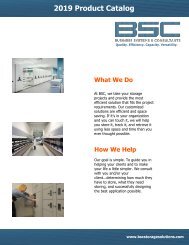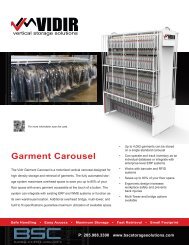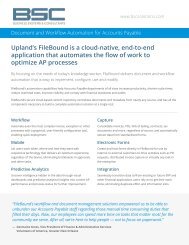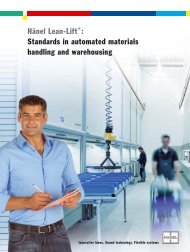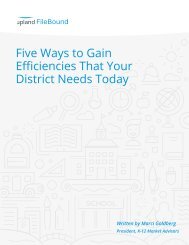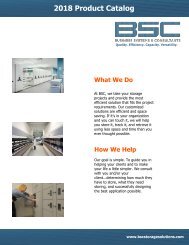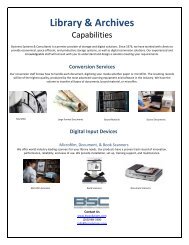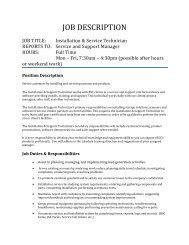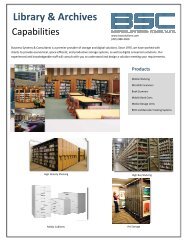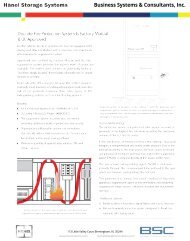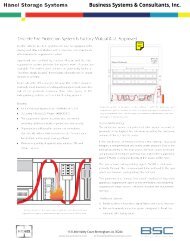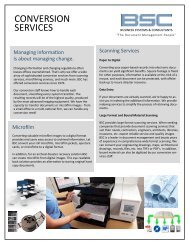Considerations for Purchasing Used ASRS Equipment
Create successful ePaper yourself
Turn your PDF publications into a flip-book with our unique Google optimized e-Paper software.
White Paper<br />
<strong>Considerations</strong> <strong>for</strong> <strong>Purchasing</strong> <strong>Used</strong><br />
Automated Storage and Retrieval <strong>Equipment</strong>
When considering the purchase of used automated storage and<br />
retrieval equipment, it is important to consider all of the factors that<br />
may affect cost and operation. A used machine may not be compatible<br />
with existing infrastructure such as electrical supply and data<br />
networks, and could potentially require costly updates in order to<br />
meet current codes and safety standards<br />
This white paper has been published by the Carousel and Vertical<br />
Lift Module (C/VLM) working group of MHI to provide guidance<br />
when considering a used carousel or vertical lift module. Our goal is<br />
to help equipment buyers make the best decision possible through<br />
in<strong>for</strong>mation and education.
Consideration #1: Condition<br />
The first consideration should be the current condition of the equipment, regardless of its age.<br />
Do not assume that a newer unit is automatically in better condition than an older machine.<br />
Routine maintenance, usage intervals and environment have a greater impact on the condition<br />
of a machine than the calendar.<br />
A newer machine that sees continual usage <strong>for</strong> 3 shifts a day, 7 days a week, 365 days a year<br />
will have much greater wear on components than an older machine that is used only sporadically.<br />
Maintenance plays a vital role in the condition of a piece of equipment. A machine that<br />
has been under a preventive service contract its entire life will be in much better shape than<br />
one that has only been repaired in the event of a breakdown.<br />
The workload of the machine plays a large role in its maintenance requirements. The average<br />
weight of the items stored in the machine should be within the rated capacity of the unit.<br />
The daily operation of the machine should match the rated duty cycle of its motors. Components<br />
will wear faster if the machine is operated at the limits of its rated capacity and beyond.<br />
Knowing the operational and service history of a unit is there<strong>for</strong>e very helpful in determining<br />
its current condition.<br />
The environment in which the machine was installed also plays a role in determining its potential<br />
condition. Ensure that the unit was well protected from the elements. The environment<br />
surrounding the machine should be maintained within the temperature and humidity levels<br />
recommended <strong>for</strong> the motors and electronic components. If the machine was operating in a<br />
relatively dirty environment such as a factory floor or machine shop, extra cleaning and maintenance<br />
are required. A machine may be cleaned and repainted to prepare it <strong>for</strong> resale, so it<br />
is important to check the service history with the<br />
original equipment manufacturer.<br />
The most reliable way to determine the condition<br />
of used equipment is research and inspection. A<br />
reputable reseller should be familiar with the machine’s<br />
history and be willing to share the details<br />
of its use. They may also put you in contact with<br />
the machine’s previous owner. By providing the<br />
serial number to the original manufacturer of the<br />
machine, you may be able to obtain a service history<br />
report, original manufacture date, and original<br />
install date among other valuable in<strong>for</strong>mation.<br />
A thorough inspection of the machine should be<br />
per<strong>for</strong>med by a factory-trained and authorized<br />
service person. Only someone who is familiar with<br />
the operation and maintenance of the machine<br />
is capable of determining if it has been properly<br />
maintained and is capable of proper operation.
Consideration #2: Configuration<br />
The physical configuration of most Automated Storage and Retrieval equipment is designed<br />
to be compatible with the needs of the original installation. Moving AS/RS equipment to a<br />
new location may require expensive and time-consuming reconfiguration.<br />
The carriers (shelves) of most automatic storage and retrieval units are designed to accommodate<br />
the size, weight, and layout of the parts the original user was storing. Most dividers and<br />
bins can be reconfigured or replaced, but some are permanent and may not accommodate<br />
new equipment or additional weight.<br />
A carousel can contain several hundred trays or bins that can be expensive to replace if they<br />
do not match your size requirements or labeling needs. The cost of replacing a large number<br />
of bins can often offset the savings of buying a used machine.<br />
Most C/VLM machines feature a standard-height access point <strong>for</strong> ergonomic reasons, but<br />
custom locations and dimensions are not uncommon. If you have requirements such as<br />
<strong>for</strong>klift access, overhead crane access or wheelchair access, these modifications to a used<br />
machine may significantly impact the cost and complexity of retrofitting a used machine.<br />
Machines are often constructed of several large sub-components. Be sure to verify the size<br />
of the components of the unit to ensure that they can be transported to your desired installation<br />
site. A machine originally installed in a warehouse with large doors and a loading dock<br />
may not break down small enough to be used in an office building.<br />
Other equipment details such as the location of the service doors, electrical requirements of<br />
the motors, lighting and seismic considerations may also play a part in determining how much<br />
work will be required to make a used piece of equipment work in your location.
Consideration #3: Safety<br />
Safety should be the most important factor when considering the purchase of used C/VLM<br />
equipment. Never accept any equipment that has missing or inoperative safety protections.<br />
Ensure that all safety systems that the machine was originally equipped with are in place and<br />
operational. If any system has bypassed or removed, it must be restored to proper operation<br />
be<strong>for</strong>e the equipment can be put back into service. All warning labels and instructional placards<br />
must be in their designated locations and be clearly visible and legible.<br />
Older equipment may not adhere<br />
to the latest OSHA and<br />
ANSI safety standards. An older<br />
machine could require extensive<br />
updates in order to be compliant<br />
with current regulations.<br />
Be certain to check your local<br />
codes to ensure compliance.<br />
Older equipment may not have<br />
the latest developments in<br />
ergonomics, lighting, ease of<br />
use, access position and user<br />
interface. These features may<br />
reduce the productivity of the<br />
machine and hamper adoption<br />
of the equipment by employees.<br />
These factors must be taken<br />
into consideration when considering<br />
new equipment vs used.<br />
Consideration #4: Maintenance and Support<br />
All mechanical equipment should receive routine maintenance, and may require ongoing technical<br />
support. It is important there<strong>for</strong>e to determine what level of service you will have available<br />
<strong>for</strong> a used machine.<br />
Most C/VLM machines require expert installation by a factory-certified service technician.<br />
Certified personnel may also be required <strong>for</strong> setup assistance, programming, and training.<br />
Older machines may not be eligible <strong>for</strong> these services, so check with the seller <strong>for</strong> in<strong>for</strong>mation<br />
on 3rd party service and support available in your area.<br />
The age of used equipment often affects the availability of spare and replacement parts.<br />
Be<strong>for</strong>e purchasing used equipment, be certain to investigate the availability of parts <strong>for</strong> the<br />
model that you are considering.
Color touchscreens, barcode scanners and RFID<br />
identification are just some of the many options<br />
available to boost the productivity of today’s<br />
automated storage and retrieval equipment.
Consideration #5: Productivity and Compatibility<br />
<strong>Used</strong> machines will not offer the same level of productivity, safety, inventory management options<br />
or security as a newer model. Operating costs including electrical consumption, routine<br />
maintenance and labor costs can increase the life cycle cost of a used machine. Older machines<br />
may not be compatible with the latest computer technology as well.<br />
Older machines may lack the necessary<br />
interfaces, connections and controls to<br />
interface with modern computer networks.<br />
Integration of an older machine<br />
into a modern MRP software system<br />
can be difficult and cost-prohibitive.<br />
Have a systems integration professional<br />
compare the technical requirements<br />
of your installation with any potential<br />
equipment to determine compatibility.<br />
Older machines do not have modern,<br />
computerized control interfaces. They<br />
may not be compatible with time and<br />
money saving innovations such as<br />
batch processing, lending management,<br />
password access and minimum<br />
inventory levels. Be sure to include the<br />
improved productivity, security and operating<br />
cost of a newer machine when<br />
considering to cost of purchasing used.<br />
Older machines may not be compatible with all of the material handling equipment currently<br />
in use at your facility. Badge readers, barcode scanners, pick-to-light systems, label printers<br />
and RFID systems that are currently in use may not interface with an older machine.<br />
Consider how critical the operation of used equipment will be, and the value of inventory<br />
stored within. <strong>Used</strong> equipment will not feature the redundancies and bypass systems of<br />
newer equipment and may not remain safely in operation in the event of a system fault.<br />
Conclusion<br />
When considering a used carousel or vertical lift module, the purchase price should be one of<br />
several important factors to consider. Installation, ongoing maintenance, upgrades, and per<strong>for</strong>mance<br />
are all key factors in determining the true cost of a machine.
To learn more, visit the Material Handling Industry at:<br />
www.mhi.org<br />
10/15/2012



